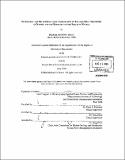| dc.contributor.advisor | Peter B. Keleman and Greg Hirth. | en_US |
| dc.contributor.author | Braun, Michael Geoffrey, 1973- | en_US |
| dc.contributor.other | Woods Hole Oceanographic Institution. | en_US |
| dc.date.accessioned | 2005-11-03T16:58:54Z | |
| dc.date.available | 2005-11-03T16:58:54Z | |
| dc.date.copyright | 2004 | en_US |
| dc.date.issued | 2004 | en_US |
| dc.identifier.uri | http://hdl.handle.net/1721.1/29538 | |
| dc.description | Thesis (Ph. D.)--Joint Program in Oceanography/Applied Ocean Science and Engineering (Massachusetts Institute of Technology, Dept. of Earth, Atmospheric, and Planetary Sciences; and the Woods Hole Oceanographic Institution), 2004. | en_US |
| dc.description | Includes bibliographical references. | en_US |
| dc.description.abstract | Observations at mid-ocean ridges indicate that magmas are focused to the ridge axis by a network of porous dunites in near chemical isolation. This thesis investigates several of the outstanding questions regarding the mechanisms of melt transport and its effects on the shallow mantle. Chapter 1 details the current understanding of melt migration from observations at mid-ocean ridges and ophiolites. Chapter 2 uses the size distribution and abundance of dunites measured in the Oman ophiolite to place limits on the potential mechanisms by which dunites form and subsequently estimate the flux of chemically unequilibrated melt which a network of dunites can supply. Chapter 3 characterizes the chemical composition of dunites and harzburgites from Oman to further constrain the process by which dunites form and relates the observed trends within dunites to variations in the time-integrated melt/rock ratio. Chapter 4 examines the microstructures of peridotites in Oman to constrain the deformation mechanisms which determine the viscosity of shallow mantle. Chapter 5 is a numerical investigation of advection beneath ridges incorporating the rheology inferred from the observed microstructures. Chapter 6 integrates the conclusions of the previous chapters, reevaluating the potential melt flux through dunites and constraining the permeability of the shallow mantle. | en_US |
| dc.description.statementofresponsibility | by Michael Geoffrey Braun. | en_US |
| dc.format.extent | 212 p. | en_US |
| dc.format.extent | 14486107 bytes | |
| dc.format.extent | 14513507 bytes | |
| dc.format.mimetype | application/pdf | |
| dc.format.mimetype | application/pdf | |
| dc.language.iso | eng | en_US |
| dc.publisher | Massachusetts Institute of Technology | en_US |
| dc.rights | M.I.T. theses are protected by copyright. They may be viewed from this source for any purpose, but reproduction or distribution in any format is prohibited without written permission. See provided URL for inquiries about permission. | en_US |
| dc.rights.uri | http://dspace.mit.edu/handle/1721.1/7582 | |
| dc.subject | /Woods Hole Oceanographic Institution. Joint Program in Oceanography/Applied Ocean Science and Engineering. | en_US |
| dc.subject | Earth, Atmospheric, and Planetary Sciences. | en_US |
| dc.subject | Woods Hole Oceanographic Institution. | en_US |
| dc.title | Petrologic and microstructural constraints on focused melt transport in dunites and the rheology of the shallow mantle | en_US |
| dc.type | Thesis | en_US |
| dc.description.degree | Ph.D. | en_US |
| dc.contributor.department | Joint Program in Oceanography/Applied Ocean Science and Engineering | en_US |
| dc.contributor.department | Woods Hole Oceanographic Institution | en_US |
| dc.contributor.department | Massachusetts Institute of Technology. Department of Ocean Engineering | |
| dc.identifier.oclc | 57561385 | en_US |
